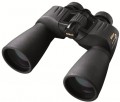Min. focus distance
The smallest distance to the observed object, at which it will be clearly visible through binoculars / monoculars. All such optical instruments were initially created for observing remote objects, therefore, not all of them are able to work at short distances. When choosing a model for this parameter, one should proceed from the expected observation conditions: ideally, the minimum focus distance should not be greater than the smallest possible distance to the observed object.
Eye relief
The offset is the distance between the eyepiece lens and the exit pupil of an optical instrument (see "Exit Pupil Diameter"). Optimum image quality is achieved when the exit pupil is projected directly into the observer's eye; so from a practical point of view, offset is the distance from the eye to the eyepiece lens that provides the best visibility and does not darken the edges (vignetting). A large offset is especially important if the binoculars / monoculars are planned to be used simultaneously with glasses — because in such cases it is not possible to bring the eyepiece close to the eye.
Prism material
Material used for prisms found in binoculars and monoculars.
-
BK-7. A type of borosilicate optical glass (6LR61), a relatively inexpensive and at the same time quite functional material that provides, although not outstanding, quite acceptable image quality. Used in entry-level and mid-level models.
—BaK-4. Barium optical glass, noticeably superior to BK7 in brightness and image clarity, is however also more expensive. Accordingly, it is found mainly in the premium segment.
Nitrogen filled
The presence of a
special gas in the body of binoculars / monoculars — usually nitrogen or argon. Due to its chemical inertness, such a gas does not oxidize internal parts (unlike the oxygen contained in the air). In addition, this function assumes the tightness of the case, which allows most of these binoculars to endure even diving under water (for more details, see "Dust and water protection"), and also protects the optics from the harmful effects of fog. All this has a positive effect on the reliability and service life of the device. In turn, the gas filler itself contains practically no water vapor — thanks to this, the lenses do not fog up from the inside, as happens with conventional models during temperature changes.
Shockproof
The presence in the design of binoculars/monoculars of a
reinforced body that protects sensitive optics from bumps and falls. The degree of such protection may vary between models, but even the simplest of them can usually withstand an accidental fall from your hands onto a hard surface without stones or other dangerous objects.
Dustproof, water resistant
The body of the binocular / monocular
is protected from dust and moisture. You should pay attention to such models if you plan to use the device in nature — while hiking, hunting, fishing, etc. The degree of such protection can vary, from splash resistance to water immersion; this point should be clarified according to the official characteristics. Also note here that most of the "waterfowl" models usually have gas filling (see above), and the absence of such filling, usually, indicates low moisture resistance.
Tripod adapter
The presence in the design of the binoculars / monocular
socket for attaching an adapter for a tripod(the adapter itself is not included in the kit, unless otherwise indicated). This feature is especially important for high magnification models (see above): they are usually heavy, making it difficult to hold stable in your hands, and at high magnification, even slight shaking can make observation impossible. In addition, mounting on a tripod is convenient for constant observation of a certain place, and such observation does not always require high magnification. Therefore, even fairly small devices can have the possibility of attaching an adapter. The adapters themselves can be designed for different sizes of tripod mounts — this must be taken into account when choosing such a model.

